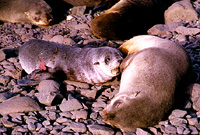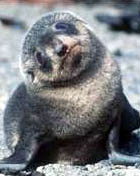|
Antarctic Fur
Seal
Antarctic fur seals are
mammals. This means that they are warm-blooded animals. Their
scientific name is Arctocephalus gazella. Antarctic
fur seals are quite large animals. The adult fur seal ranges from
one hundred and seventy to two hundred centimetres tall. The bull (male fur seal) is approximately
ninety to two hundred kilograms in weight. The cows (female fur seal) weight is
between twenty to fifty one kilograms. Pups (baby seals) are
sixty to seventy centimetres tall at
birth and weigh five to six kilograms. The back sides of the adults are grey to
brownish with creamy throat and chest and a dark gingery ventral.
These seals have slanted eyes, small ears and thick soft fur. The
thick soft coat helps insulate their body from the cold ice. Males
have manes with a lot of white hairs, which give the males a
grizzled look. Male Antarctic fur seals are called bulls, female Antarctic fur seals are called
cows, and baby seals are called pups. Pups are very dark
brown or black.  Antarctic
fur seals live in an extremely cold condition. They need something
in their body or on their body to stay warm. For example, the fish
in the Antarctic oceans have antifreeze in their body which helps
them stay warm and their blood not to freeze when there is severe
coldness. Antarctic fur seals have a thick coat of blubber (fat),
which keeps them very warm. Antarctic
fur seals live in an extremely cold condition. They need something
in their body or on their body to stay warm. For example, the fish
in the Antarctic oceans have antifreeze in their body which helps
them stay warm and their blood not to freeze when there is severe
coldness. Antarctic fur seals have a thick coat of blubber (fat),
which keeps them very warm.
Antarctic
fur seals mainly feed on krill, but also takes fish, squid and
birds. Feeding dives occur mainly at night, between eight and nine
at night and at two to three in the morning. In diving bouts, the
seal make about nineteen dives per hour. All dives are shallow.
Twenty-one to thirty metres, is the maximum recorded dive by an
Antarctic seal. Antarctic
fur seals mature at different ages. The cows usually become mature
at the age of three to four, and on the other hand, the bulls
mature at six to seven years of age. Antarctic
fur seals main breeding area is in South Geoargia. Other breeding
colonies can be found on the South Sandwich Islands, Bouvetya,
South Shetland, Marlon Island, Heard, Mcdonald Isalands and
possibly on Kerguelen. These species
breed sympathetically with Arctocephalus tropicalis and may be
competing for space and food. The pregnancy rate for Antarctic fur
seals is unknown. These species do not migrate. rate for Antarctic fur
seals is unknown. These species do not migrate. Antarctic
fur seals are found on the islands south of the Antarctic
convergence and north of sixty five degrees latitude. Fur seals
flock together on the shore and shingle beaches to breed. Everyday
there are fights between male fur seals and female fur seals on
the beach whether who is first on land. The fight usually
ends with blood flowing from the skin. Some fights usually end
up with males dead or passed out. Males
live just over thirteen years. Females live just over twenty three
years. The bulls (males) stake out their own territory on the
beach and defend it. They breed with the cows (females) on the
territory. The females are much luckier than the males. BIBLIOGRAPHY
http://ourworld.compuserve.com/homepages/jaap/furseals.htm Brasch,
N. (2001) Antarctica. Port Melbourne: Heinemann Library. Gough,
S. (1992) Creatures of the Antarctic. Melbourne: Rigby.
| Learning
Process & Self Evaluation: |
| Steps I went
through to create this report: |
- Research information on the
internet.
- Research information from
books.
- Find interesting pictures.
|
| I have learnt: |
- I have learnt many different.
facts whilst doing this task on the Antarctic fur seal.
- To use Microsoft FrontPage.
|
| I am good at: |
- Being focused on the
main topic whilst working.
- Elongating paragraphs.
|
| I need to work
more on: |
- Researching harder for information.
- Finishing the task quicker
but using the same care for the work.
- Finding much more
interesting information.
|
| My
effort for this task has been: |
Quality |
My
best work |
Could
do better |
| |
ü |
|
| Comment:
I have found this animal very
interesting to research. It has broadened my experience to use a
computer by using Microsoft FrontPage and the edit option. I
hope to receive tasks like this more often. Also during the
duration of this task, I have learnt a great deal on the
Antarctic Fur Seal. |
|
| Teacher
Evaluation: |
| Indicator |
Progressing
Towards |
Achieved |
Working
Beyond |
| Locating
Information |
|
|
|
| Records information
from a variety of sources |
|
ü |
|
| Information is
written in 'own words' |
|
|
ü |
| Report
Structure |
|
|
|
| Text presents
factual information by classifying a class of things and then
describing the characteristics |
|
|
ü |
| Uses the animal as a
theme in sentences |
|
|
ü |
| Information of the
same type is grouped together |
|
|
ü |
| Paragraphing is used
to organise generic stages |
|
|
ü |
| Each paragraph has a
topic sentence and/or heading |
|
ü |
|
| Includes a correctly
set out bibliography |
|
|
ü |
| Grammar |
|
|
|
| Writes in timeless
present tense |
|
|
ü |
| Sentences are
correctly structured and there is subject/verb agreement |
|
|
ü |
| Writes complex
sentences |
|
ü |
|
| Uses pronouns and
reference chains correctly |
|
|
ü |
| Uses correct
punctuation |
|
|
ü |
| Spells needed words
correctly (has used Spell Check) |
|
|
ü |
| Presentation |
|
|
|
| Uses accepted typing
conventions |
|
|
ü |
| Uses a variety of
print and script styles for effect |
|
|
ü |
| Includes graphics |
|
|
ü |
| Effective, easy to
read layout |
|
|
ü |
| Comment:
Well done Mariam, your report has given a vivid description of
Antarctic fur seals. You have found a lot of very good
information and written it in your own words. Your report
is also very well presented. Keep up the good work.
Miss Johnstone |
|
|